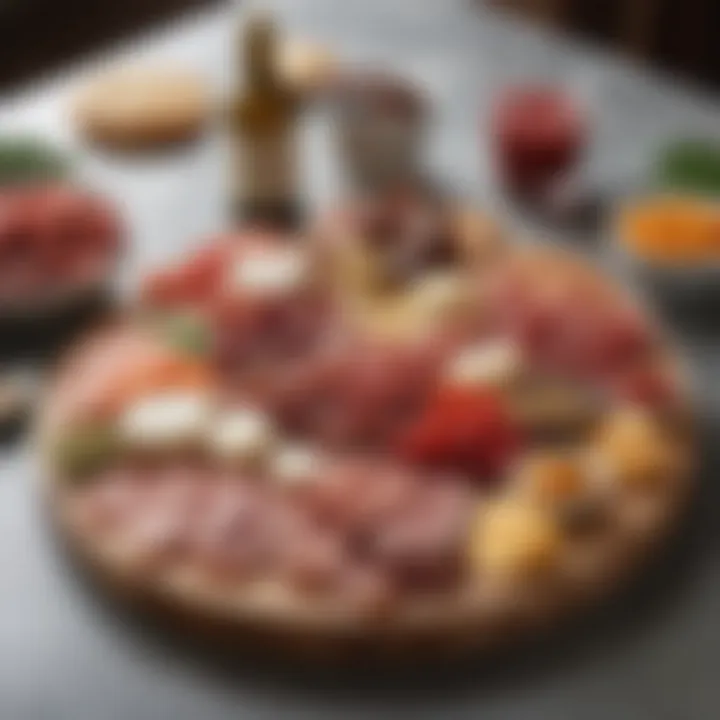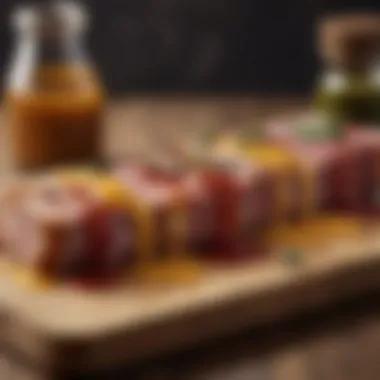Crafting Perfect Sauces to Elevate Your Charcuterie Board


Intro
When it comes to charcuterie boards, the focus often lands on the meats and cheeses. However, the sauces truly elevate the entire experience. They offer contrast, balance, and an explosion of flavors that complement the rich and savory ingredients. This article seeks to explore the art of crafting the perfect sauces that enhance your charcuterie presentation.
A well-thought-out sauce can pull together various elements on the board, offering both visual appeal and taste complexity. The keys to successful sauces are understanding flavor profiles, knowing ingredient compatibility, and mastering preparation techniques. Whether you prefer a classic mustard or an adventurous fruit chutney, the right sauce can make your charcuterie board unforgettable. We will discuss different types of sauces, essential ingredients, and practical tips to guide you in this culinary journey.
Recipe Overview
Recipe Name
Charcuterie Sauce Selection
Description of the Dish
This collection features a range of sauces tailored for charcuterie boards. From creamy dips to zesty spreads, each sauce brings unique flavor components to the table. Their variety ensures that every palate can find something pleasing, making your board a conversation starter and a delightful experience.
Ingredients
List of Ingredients with Measurements
- Honey Mustard Sauce
- Herbed Cream Cheese Spread
- Savory Fruit Chutney
- 1/2 cup Dijon mustard
- 1/4 cup honey
- 1 tablespoon apple cider vinegar
- Salt to taste
- 8 oz cream cheese, softened
- 1/4 cup sour cream
- 2 tablespoons fresh chives, chopped
- 1 tablespoon fresh parsley, chopped
- 1 teaspoon garlic powder
- 1 cup chopped fruits (apples, pears, or figs)
- 1/4 cup sugar
- 1/2 cup apple cider vinegar
- 1/4 teaspoon ground cinnamon
- 1/4 teaspoon black pepper
Special Notes on Ingredients
- For the honey mustard sauce, you can substitute maple syrup for honey if necessary.
- Fresh herbs in the cream cheese spread can be swapped with dried herbs in a pinch, but use less quantity.
- Local seasonal fruits work well for chutney, so consider using what is available in your area to create an enticing flavor.
Having a variety of sauces allows for a range of tastes on your charcuterie board, ensuring that there is something to suit every guest's preference.
By blending these different sauces, your charcuterie board will not only be aesthetically pleasing, but it will also offer an enhanced sensory experience. The key to excellent charcuterie lies in thoughtful pairing, delicate balance in flavor, and a touch of personal style.
Foreword to Charcuterie Boards
Charcuterie boards have gained immense popularity in recent years. They represent not just platters of food but also an art form that emphasizes presentation. The combination of various meats, cheeses, fruits, and sauces creates a culinary experience. This article explores how sauces can elevate the simplicity of a charcuterie board, making its flavors more complex and varied. Understanding what makes a charcuterie board exceptional starts with recognizing its components and the role of sauces in enhancing these elements.
Historical Background of Charcuterie
Charcuterie has its roots in ancient France. Initially, it referred to the art of preserving meats such as sausages, pâtés, and cured hams. The term comes from the French word "chair" meaning meat, and "cuit" meaning cooked. Originally, charcuterie was a means of food preservation in the absence of modern refrigeration. Today, this practice has evolved into a celebration of flavors, textures, and colors, often featuring an array of components on a single board.
A pivotal moment for charcuterie occurred in the 15th century. At this time, French cooks began showcasing their craftsmanship. Over centuries, the practice spread across Europe, leading to regional variations. For instance, Spanish tapas often feature cured meats with olives and cheese, while Italian antipasto focuses on marinated vegetables and Italian meats. The influence of these traditions contributes to the rich tapestry of charcuterie available today.
Elements of a Charcuterie Board
A well-crafted charcuterie board consists of several key elements that work harmoniously.
- Cured Meats: Salami, prosciutto, and other cured meats bring depth to the flavor profile. Their varying spice levels and fat contents offer a range of tasting experiences.
- Cheeses: Different types of cheese can elevate the board significantly. Hard cheeses like aged cheddar contrast beautifully with soft brie or goat cheese. The variety allows for a juxtaposition of textures and tastes.
- Accompaniments: Items such as olives, pickles, nuts, and dried fruits add additional layers. They provide sweetness, acidity, and crunch that balance the richness of meats and cheeses.
- Sauces and Spreads: This is where flavors truly come alive. Sauces can transform the tasting experience. Options like honey, mustards, or savory dips complement the richness of meats and cheeses, enhancing the overall enjoyment.
In summary, each element on a charcuterie board plays a vital role in creating a cohesive and enjoyable experience. By understanding these elements and their interactions, one can craft a remarkable presentation that pleases the palate.
The Role of Sauces in Charcuterie
Sauces occupy a critical position in the context of charcuterie boards. They not only enhance the overall experience but also serve to unite the various elements present on the board. Important considerations include balancing flavors, complementing various ingredients, and adding depth to the tasting experience. A well-chosen sauce can elevate common ingredients like cured meats and cheeses, transforming a simple presentation into something truly memorable.
Enhancing Flavor Profiles
Flavor enhancement is essential when crafting a charcuterie board. Sauces introduce unique taste components that can either contrast or harmonize with the existing flavors. For instance, a sharp whole grain mustard can cut through the richness of creamy cheese, providing a refreshing balance. Other sauces like fig jam can add a sweet note, pairing beautifully with salty meats.
By understanding the role of different sauces, one can successfully highlight specific notes in meats, cheeses, and other components. Experimenting with various combinations—such as spicy brown mustard with peppered salami or herbed mayonnaise with smoked turkey—can lead to surprising and delightful pairings. Each sauce contributes distinct layers, ideal for creating a multi-dimensional tasting journey.
Visual Appeal and Presentation
The visual aspect of a charcuterie board significantly influences its appeal. Sauces can create attractive contrasts against the colors of meats, cheeses, and vegetables. For example, a bright red pepper jelly adds a pop of color that can draw the eye. Presentation plays a pivotal role in making the board inviting and memorable.
Utilizing small dipping bowls for sauces can provide an organized look while allowing guests to easily access different flavors. Drizzling sauces artfully over cheeses or spreading them across the board can also enhance aesthetics. Simple garnishes, like fresh herbs beside a rich herb labneh, can elevate the presentation further. This attention to visual detail can turn an ordinary charcuterie spread into an impressive centerpiece for any gathering.
The right sauce not only enhances flavor but also transforms the visual impact of a charcuterie board, making it an essential part of your presentation strategy.


Classic Sauce Options
Classic sauces offer foundational flavors that significantly elevate any charcuterie board. They play a crucial role in complementing the nuts, meats, and cheeses by adding contrasting textures or enhancing the board's overall taste experience. When choosing sauces, consider how each option can influence flavor interplay. A thoughtful selection can enhance not only taste but also the visual appeal of your spread.
Mustard Varieties
Mustards are a staple among charcuterie sauces, providing a sharpness that cuts through fatty meats and rich cheeses. Their versatility makes them an essential component when crafting your board.
Whole Grain Mustard
Whole grain mustard is characterized by its visible mustard seeds, which provide a pleasant crunch. This texture adds a delightful dimension to dishes. Its slightly sweet and tangy flavor profile pairs well with a variety of meats and cheeses. Whole grain mustard's adaptability makes it a favorite choice. It enhances flavor without overpowering other ingredients. However, its robust flavor may not suit everyone's palate. Consider serving it alongside milder options for balance.
Dijon Mustard
Dijon mustard is smooth and creamy with a distinct sharpness that enhances various foods. Its ability to complement everything from meats to bread makes it a reliable choice for any charcuterie board. Commonly recognized for its complex flavor, Dijon offers a good balance of acidity and spice. This makes it particularly effective with rich cheeses like Brie or aged Gouda. One possible downside is that its pronounced flavor may not appeal to guests who prefer milder sauces.
Spicy Brown Mustard
Spicy brown mustard features a stronger kick than its yellow counterpart, making it ideal for those who enjoy a bit of heat. It has a coarser texture and blends well with a variety of meats, especially sausages and salami. The depth of flavor and heat can elevate the overall taste experience of your charcuterie arrangement. However, some may find its robust spiciness overwhelming when paired with more delicate items.
Mayonnaise-Based Sauces
Mayonnaise-based sauces add a creamy and rich element to your charcuterie board. These sauces can be tailored to match the overall theme of your display.
Garlic Aioli
Garlic aioli presents a luxurious richness and is perfect for spreading on bread or dipping vegetables. Its creamy texture and pungent garlic flavor create an inviting contrast to salty meats. This sauce provides depth and sophistication. While aioli is flavorful, it may not be suitable in diets limited in fats. Balance is key when using it alongside more acidic items.
Herbed Mayonnaise
Herbed mayonnaise brings in fresh flavors that can enhance many dishes. The combination of herbs offers brightness and a touch of luxury, allowing it to pair well with lighter cured meats and soft cheeses. It works as a great alternative to traditional mayonnaise, adding an element of freshness. Some diners, however might find it too herbaceous or heavy depending on the herbs chosen.
Chipotle Mayo
Chipotle mayo stands out due to its smoky and spicy flavor. This sauce enriches meats and can also be used with vegetables. The smoky flavor profile provides an exciting contrast against sweeter components. It tends to draw those who enjoy bold flavors into an altogether unique pairing experience. Care should be taken to not serve it with items that are too delicate, as the strong flavor could overwhelm.
Vinaigrettes and Dressings
Vinaigrettes and dressings offer a lighter, more zesty approach to sauce offerings. They can perk up the flavors of fatty items and enhance freshness.
Balsamic Vinaigrette
Balsamic vinaigrette has a sweet and tangy flavor, ideal for drizzling over cheeses or vegetables. Its sweetness pairs particularly well with rich, creamy cheeses like mozzarella, thus creating a pleasing contrast in taste. The rich, dark color can add visual appeal to your board. On the downside, guests who prefer milder flavors may find it slightly overpowering.
Apple Cider Vinaigrette
Apple cider vinaigrette is another great option that brings fruit notes and acidity to the table. Its slightly sweet nature balances well with savory meats and cheeses, making it versatile. When combined with fresh salad greens or even drizzled over roasted vegetables, it shines. However, its sweetness might not appeal to those who opt for more traditional, less fruity dressings.
Herbed Olive Oil
Herbed olive oil provides a fragrant finish to various charcuterie options. This sauce blends well with breads and can be a dipping oil for fresh vegetables. The freshness of the herbs adds a vibrant touch to every bite. Its versatility makes it valuable for many charcuterie applications, but for anyone sensitive to oil, portion control is important.
Unique and Trending Sauce Innovations
In the evolving landscape of culinary creativity, unique and trending sauce innovations have become vital for any charcuterie board. The sauces chosen can greatly elevate the overall experience. They provide distinct and often bold flavors that contrast and complement various charcuterie components. By integrating sauces that are not mainstream, one can create a remarkable sensory journey for guests. The introduction of new flavors not only broadens the palate but also encourages conversations about food. These innovations can be pivotal for any social gathering, making the charcuterie board more than just a platter of meats and cheeses, but an expression of creativity.
Fruit-Based Sauces
Fig Jam
Fig jam is a versatile option that brings a touch of sweetness to the charcuterie experience. Its sticky texture creates a delightful pairing with cheeses like goat and blue cheese. The sweetness of the figs contrasts nicely with the saltiness of cured meats, enhancing each bite. Additionally, fig jam has a natural richness that can elevate the whole board.
However, one should note that fig jam can be overly sweet for some. So, it's important to balance the sweetness with other, less sweet options on the board. Overall, fig jam is popular due to its ability to complement many ingredients while being stylish in presentation.
Spiced Apple Chutney
Spiced apple chutney offers a fusion of sweet and tart flavors, combining cinnamon, apples, and sometimes even ginger. This sauce works beautifully with brie and sharp cheddar. The spices add warmth, making it a cozy addition to colder months.
The disadvantage of spiced apple chutney lies in its specific flavor profile, which may not appeal to everyone. Also, it can overshadow more subtle cheeses, so pairing should be done thoughtfully. Despite this, its ability to add depth makes it a preferred choice for many hosts.
Peach Salsa
Peach salsa introduces a refreshing, vibrant twist to a charcuterie board. The juicy peaches combined with cilantro and a hint of lime bring brightness that cuts through richer meats. Ideal alongside prosciutto, it enhances the flavor experience without overwhelming other elements.


However, it may not be everyone's favorite, as the unique combination of ingredients may not suit all palates. Still, its unique feature of being light and fresh makes it a beneficial choice, especially in warmer seasonal gatherings.
Spicy Sauces for Bold Flavors
Sriracha Honey Sauce
Sriracha honey sauce is a dynamic blend of heat and sweetness. This sauce creates a striking contrast when dipped with crispy fried snacks or even drizzled over soft cheeses. The balance of flavors resonates well with many who prefer a kick in their meals.
The potential downside of this sauce is that it might be too spicy for some. Not everyone enjoys heat, and thus a moderate serving should be considered. Regardless, its distinctive flavor profile makes it an attractive option for daring hosts.
Chili Garlic Sauce
Chili garlic sauce provides an intense flavor experience. The blend of garlic and chili creates a bold punch, making it excellent for pairing with hearty meats. This sauce brings complexity to traditional charcuterie, appealing to adventurous eaters.
However, much like the previous sauces, it may not be favored by all due to the strong flavors involved. Excessive use can overshadow the subtleties of other ingredients on the board. It’s best to offer small servings to maintain balance within the overall spread.
Cajun Remoulade
Cajun remoulade is a zesty sauce that adds depth with its blend of bold spices and herbs. It's perfect for dipping veggies and seafood, making it a unique choice. Its richness provides a southern twist that pairs perfectly with certain cured meats.
Nevertheless, the unique flavors in Cajun remoulade may limit its versatility on a charcuterie board. Not every guest may enjoy its spiced nature. Still, it remains a celebrated option for those looking to showcase regional styles.
Herbed and Spiced Dips
Green Goddess Dressing
Green goddess dressing has gained renewed popularity due to its fresh, herbaceous flavors. Often made from herbs, yogurt, or sour cream, its creamy consistency pairs impressively with fresh vegetables and cheeses. The versatility and freshness are key characteristics that attract those seeking light dipping options.
However, its consistency may not suit everyone’s tastes. Some might prefer lighter dips, so it’s wise to provide a range of options. Yet, it brings a feel of freshness, making it a popular ingredient on many boards.
Chimichurri
Chimichurri sauce is a vibrant, herbal sauce that originates from Argentina. Its distinctive green color and robust flavor profile make it a bold addition to meat-centric charcuterie. This sauce pairs surprisingly well with many cured meats, infusing them with a fresh and tangy taste.
Nonetheless, its herb-forward nature may not resonate with every palate. It’s essential to balance it with milder flavors on the board. Still, it remains an engaging option for culinary adventurers.
Herbed Labneh
Herbed labneh adds a smooth, creamy option to any charcuterie display. This strained yogurt sauce, often enriched with herbs, brings a distinct tang and texture that enhances the overall experience. Pairing well with flatbreads or crispy crackers, it provides a rich contrast to crispy elements.
The consideration here is that some may find it heavier compared to vinaigrettes or lighter dips. However, its rich texture and harmonious flavors make it an enticing addition for many food lovers.
In summary, these unique and trending sauce innovations not only elevate a charcuterie board but also enrich the dining experience, allowing hosts to create memorable moments.
Pairing Sauces with Charcuterie Components
Understanding how to pair sauces with charcuterie components is vital for creating a harmonious dining experience. The right sauce can elevate the flavors of the meats, cheeses, and accompaniments on your board. It adds layers of taste, creating balance and depth. Consideration of texture and flavor profiles is crucial. Sweet, salty, spicy, and savory elements should complement each other.
When curating a charcuterie board, think about how each sauce enhances the ingredients. A well-thought-out pairing not only improves taste but also enhances the visual appeal of the board. Each component has its characteristics. Pairing sauces correctly allows the unique qualities of each element to shine through.
The ideal sauce pairing enhances the entire charcuterie experience, turning ordinary into exquisite.
Cheese Pairings
Different cheese varieties lend themselves to specific sauces. Creamy cheeses like Brie are often complemented by fruit-based sauces such as Fig Jam or Spiced Apple Chutney. The sweetness of these sauces balances the richness of the cheese. They create a delightful contrast in texture and flavor.
For sharper cheeses like aged cheddar or Roquefort, a sauce like Balsamic Vinaigrette can create a complex palate. The acidity cuts through the richness of the cheese, bringing brightness to your bite. Consider pairing Goat Cheese with herbed dressings like Green Goddess, where the herbal flavors enhance the tanginess of the cheese.
Cured Meats Compatibility
Cured meats present their unique flavor profiles. When pairing sauces with options like prosciutto or salami, think about balancing saltiness and spice. Spicy Brown Mustard is a classic pairing that complements the savory nature of these meats. It has enough punch to enhance the flavors while not overpowering them.
Another good choice is a Spicy Honey Sauce for cured meats with a hint of sweetness. The combination works surprisingly well with the saltiness of the meats, creating an inviting taste.
Pickles and Vegetables
Pickles and vegetables serve as refreshing counterparts on a charcuterie board. They offer crunch and acidity. When it comes to sauces, herbed options often work best. A Chimichurri, for example, adds a vibrant layer of flavor. The freshness of herbs combined with vinegar brightens the richness of the board.
Alternatively, a creamy Garlic Aioli can provide a soothing texture and rich flavor, countering the sharpness of pickles. This pairing invites adventure and can be versatile across the entire board.
Choosing the right sauce is not just about enhancing flavors but also about craft. Understanding the interplay between ingredients results in an elevated charcuterie experience.


Preparing and Serving Sauces
Preparing and serving sauces play a crucial role in the overall experience of a charcuterie board. They enhance flavors, offer various textures, and elevate the aesthetic appeal of the presentation. The right sauce can transform an ordinary board into something extraordinary. Therefore, understanding how to create these sauces and serve them properly can make a significant impact.
Homemade Sauce Recipes
Step-by-Step Instructions
Step-by-step instructions provide clarity in the sauce-making process. When preparing sauces, it is essential to follow these guidelines carefully to ensure consistency and flavor. This approach benefits both novice and experienced cooks. Each step typically outlines specific ingredients, measurements, and techniques. This structured method helps in achieving a desired result while minimizing errors.
A unique feature of using step-by-step instructions is that it allows for the inclusion of personal adaptations. While the basics remain, cooks can modify ratios or add unique components based on preferences. The potential downside may be the time commitment involved, especially for complex sauces.
Ingredient Substitutions
Ingredient substitutions are vital for those who have dietary restrictions or limited access to certain products. Identifying alternatives can make it easier for everyone to enjoy their charcuterie varieties. This aspect allows creativity in formulating recipes without losing the essence of the intended flavor.
The key characteristic of ingredient substitutions is their flexibility. For example, if a recipe calls for cream, a non-dairy option can be used instead. This adaptability is beneficial for this article, as it encourages accessibility to various audiences. Analyzing these substitutions could be complex, given that some may change the sauce's texture or flavor significantly.
Storage and Shelf Life
Proper storage and understanding the shelf life of sauces are crucial for preserving flavor and ensuring food safety. Different sauces have varied lifespan depending on their ingredients. For example, vinegar-based sauces often last longer than cream-based options. Before serving a sauce, knowing its recommended storage method can avoid potential food waste and health risks.
Presentation Techniques
Utilizing Dipping Bowls
Utilizing dipping bowls adds a significant visual and functional appeal to the charcuterie board. By placing sauces in small, decorative bowls, it encourages guests to explore different combinations. Each bowl can represent a distinct flavor, contributing to the overall experience. Aesthetically pleasing presentation enhances the enjoyment of food.
A notable advantage of using dipping bowls is the organization they provide on the board. Guests can sample various flavors without spilling or mixing sauces. A disadvantage includes the need for additional serving utensils, which can complicate cleaning.
Creative Garnishing
Creative garnishing elevates the aesthetics of sauce presentations. The presentation can be enhanced by sprigs of herbs, edible flowers, or colorful spices. This technique draws attention and makes the sauces enticing to guests. Besides, it reflects the effort put into creating an appealing setting.
The unique feature of creative garnishing is that it can underscore the flavors in the sauces. For instance, a sprig of rosemary can pair well with a garlic aioli. Such combinations not only enhance taste but also make the board visually pleasing. On the flip side, over-garnishing can lead to confusion about flavors or overwhelming visual clutter.
Cultural Variations of Charcuterie and Sauces
Exploring cultural variations of charcuterie and sauces reveals the rich tapestry of culinary traditions around the world. Each culture brings its distinct flavors and techniques to the table, influencing not only how charcuterie boards are assembled but also how sauces are used to enhance their appeal. Understanding these variances allows enthusiasts to expand their culinary repertoire, encouraging experimentation and appreciation of global flavors.
Spanish Tapas Influence
Spain offers a vibrant example of how charcuterie can be adapted into a tapas setting. Tapas, small dishes served as appetizers, often feature cured meats like Jamón Serrano and Chorizo. Accompanying sauces are key to enhancing the palate experience. For instance, a romesco sauce, made with roasted red peppers, almonds, and garlic, complements the smoky flavors of Spanish cured meats.
In this context, sauces are more than an afterthought; they are essential in drawing out the complexity of the ingredients. The taste of the cheese and meats can shift dramatically depending on which sauce is chosen. This approach emphasizes the importance of pairing in the art of charcuterie.
Italian Antipasti Elements
Italy is known for its antipasti, which comprises a selection of cured meats, cheeses, and marinated vegetables. The sauces commonly found in Italian antipasti are often simple yet packed with flavor. A balsamic vinaigrette can provide a sharp contrast to creamy cheeses like Mozzarella di Bufala. Similarly, a pesto sauce made from basil, garlic, pine nuts, and cheese can elevate both meats and vegetables.
The focus here is on freshness and quality of ingredients. Italian traditions prioritize using high-quality oils and vinegars, highlighting that the foundation of a great sauce is rooted in the excellence of its components.
French Charcuterie Traditions
In France, charcuterie is an art form. The French charcuterie board often comprises an array of pates, terrines, and sausages. Accompanying sauces may include mustard varieties such as Dijon, which provide a sharp bite that pairs well with fatty meats like Duck Pâté. The French also utilize cornichons, small pickled gherkins, to add acidity and cut through richer flavors.
Furthermore, French sauces reflect regional variations, including herb-infused sauces that enhance local specialties. The depth of flavors found in French sauces often stems from slow cooking and careful seasoning, allowing the sauces to meld beautifully with the charcuterie components.
Understanding these cultural variations adds depth to the practice of assembling charcuterie boards, encouraging culinary exploration.
Ending and Final Thoughts
Understanding the context of charcuterie boards and their cultural significance adds depth to the appreciation of sauces. In various traditions, sauces can symbolize regional tastes and historical practices. For food lovers, this knowledge enriches the act of assembling a charcuterie board. Ultimately, the benefits extend beyond flavor; they encompass creativity and self-expression.
When selecting sauces, considerations such as compatibility with various meats and cheeses, as well as the visual impact, play crucial roles. Carefully curated sauces can convert a simple gathering into a gourmet experience, showcasing the ability to craft unique combinations that reflect personal taste. Each sauce serves as an invitation for the hosts to communicate with their guests, encouraging them to explore and discover new flavors together.
As we digest the tips and techniques provided, it becomes clear that experimentation is key. Whether you are a novice or an experienced host, stepping out of conventional boundaries allows for an ever-evolving charcuterie experience.
Recap of Key Points
- Sauces Enhance Flavor: Each sauce is designed to complement specific elements like cheeses, meats, and vegetables, making flavor profiles more distinctive.
- Visual Appeal: The presentation of sauces plays a significant role in the perception of the charcuterie board, turning a simple assortment into an appealing display.
- Cultural Context: Various regions offer unique sauces that can provide insight into local traditions and preferences.
- Experimentation is Crucial: Trying different combinations and flavor pairings promotes creativity and improves the dining experience.
Encouragement to Experiment
Experimentation remains at the heart of crafting perfect sauces for charcuterie boards. The realm of flavors is vast, and there are no strict rules dictating what should or shouldn’t be included. Start by mixing different sauces or adding unexpected ingredients. For example, combining garlic aioli with a spiced apple chutney may create an intriguing flavor profile that surprises your palette.
Additionally, consider seasonality when selecting ingredients. Fresh herbs or seasonal fruits can elevate a sauce from standard to exceptional. Don’t shy away from the unusual—daring pairings often yield the most rewarding results. Engaging guests in the process can also add to the experience. Invite them to share their favorite combinations or even collaborate on a new sauce.
In closing, the world of charcuterie boards is rich with creativity and flavor potential. With an open mind towards experimentation, anyone can create a sophisticated and enjoyable spread that invites exploration and conversation.







